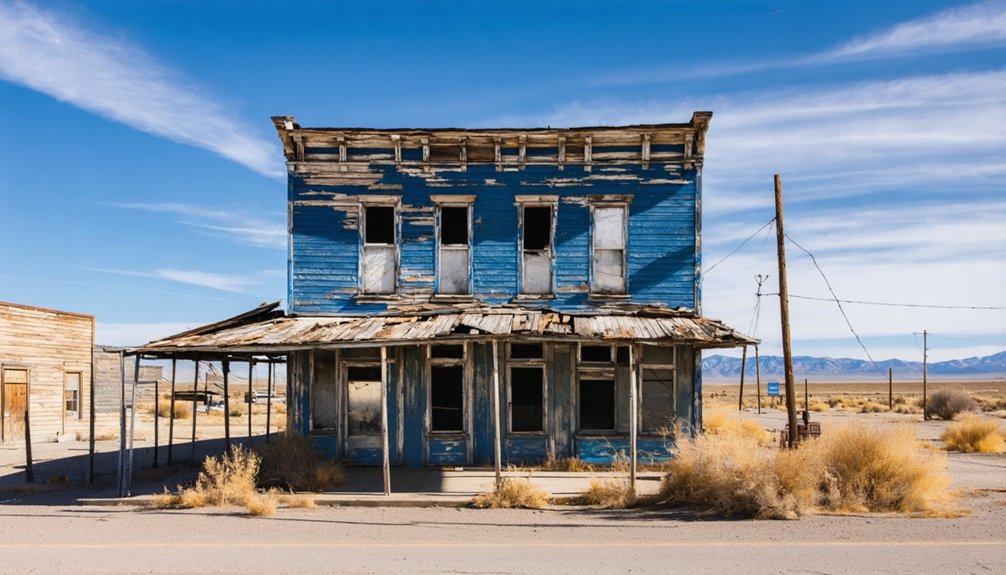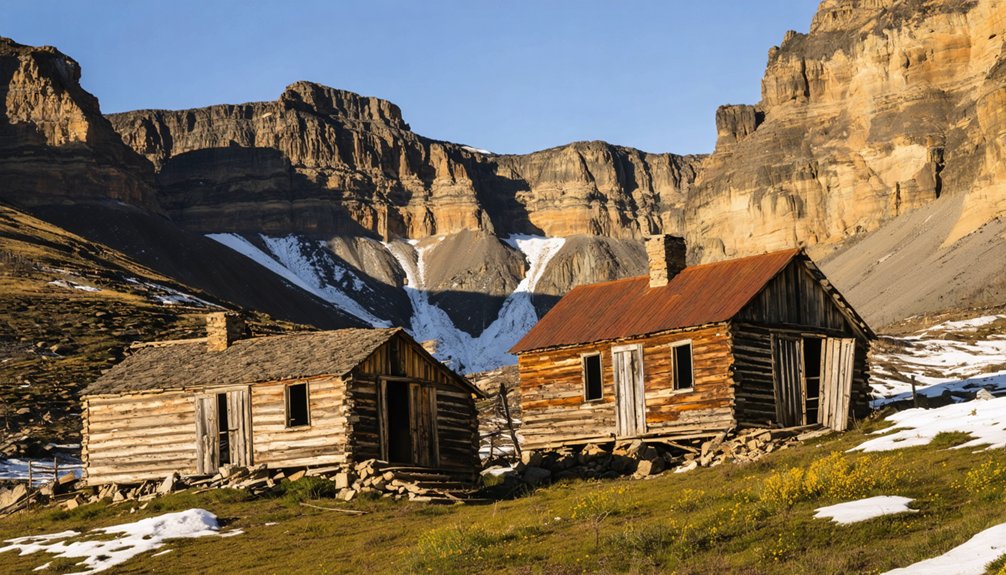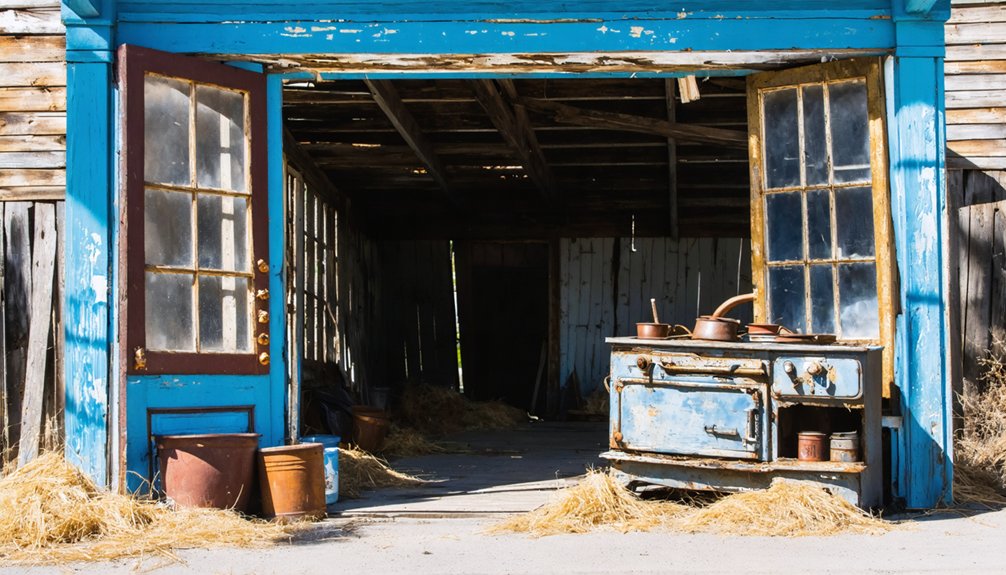When you visit Decatur, Colorado today, you’ll find only scattered ruins and weathered foundations nestled in Peru Creek Valley. This once-bustling silver mining settlement flourished briefly in the 1880s during the silver boom, named after either naval hero Stephen Decatur or a mining magazine editor. Harsh mountain conditions and the silver market collapse eventually emptied the town. The silent stone walls and rusted artifacts tell a compelling story of frontier ambition and abandonment.
Key Takeaways
- Decatur was established in 1868 after silver was discovered along Peru Creek in the 1860s.
- The town experienced a population surge during the 1880s silver boom, with advanced chlorination plants for ore processing.
- Named after naval hero Stephen Decatur, reflecting the frontier tradition of honoring American icons.
- Post office closure marked the town’s decline from a once-thriving mining settlement.
- Today, visitors can explore Decatur’s ruins including foundations, collapsed structures, and mining artifacts.
The Birth of a Mining Settlement (1880s)
While silver was discovered along Peru Creek in the 1860s, it wasn’t until 1868 that Decatur officially took shape as a mining settlement. Stephen Decatur laid out the town after the Bross party departed, establishing a foothold in Summit County’s mineral-rich landscape.
Early prospectors employed basic mining techniques, focusing primarily on placer deposits where they extracted gold and silver directly from creek beds. The Colorado mining boom attracted fortune seekers to this remote mountain location, transforming it from wilderness to boomtown. Similar to Montezuma, Decatur experienced a significant population surge during the silver boom of 1880s.
Community dynamics quickly developed around mineral extraction. As the population surged, the settlement evolved beyond just mining operations to include merchants, families, and service providers. The area later saw the introduction of more advanced chlorination plants for processing complex ores.
Despite the harsh terrain and limited infrastructure, Decatur embodied the pioneering spirit of western expansion and the quest for prosperity.
Stephen Decatur and the Town’s Namesake
When you explore the origins of Decatur’s name, you’ll find it honors Stephen Decatur, the celebrated naval officer whose heroism during the Barbary Wars and War of 1812 made him an American icon.
His legacy extended far beyond his military achievements, as his famous patriotic toast “Our country, right or wrong” resonated with the frontier spirit of the mining community. Born on January 5, 1779, in Sinepuxent, Maryland, Decatur rose quickly through naval ranks to become one of America’s first military heroes. At just 25 years old, he was promoted to captain, becoming the youngest American naval officer to achieve that rank.
The naming practice reflected a common 19th-century tradition where western settlements adopted names of national heroes, linking remote Colorado mining camps to the broader narrative of American identity and valor.
Mining Magazine Pioneer
Contrary to popular belief, the Colorado ghost town of Decatur wasn’t named after the famed naval hero Stephen Decatur (1779-1820), but rather after his namesake who made his mark in Colorado’s mining industry.
This lesser-known Decatur served as editor of the influential *Colorado Miner* magazine during the region’s mining boom. His journalistic work notably shaped mining communities through Decatur’s influence on investment patterns, settlement, and even town naming—including Silver Plume. The naval hero Stephen Decatur, by contrast, gained fame and prize money from capturing the British frigate Macedonian during the War of 1812. The original Stephen Decatur was later awarded a gold medal for his achievements during this conflict.
Through mining journalism, he documented the complex landscape of companies like Deerhorn and Summit mines while providing essential information to prospectors and investors alike.
The *Colorado Miner* under his editorship became an indispensable communication tool that united mining communities and promoted development throughout Colorado’s mineral-rich territories, making him a true pioneer of western mining media.
Namesake Beyond Mines
Despite common assumptions, the town of Decatur’s name bears a complex relationship with the famed naval hero Stephen Decatur. When you explore Decatur’s history, you’ll find the town founders likely chose this moniker to honor the celebrated commodore who became a national symbol of American courage and patriotism.
Stephen Decatur’s heroic exploits during the Barbary Wars and War of 1812 had transformed him into a household name by the time Colorado’s mining towns were being established. His dramatic mission where he burned the Philadelphia in Tripoli harbor demonstrated the daring spirit that made him legendary. His service earned him a Congressional Gold Medal after the War of 1812, cementing his status as a national hero. Local legends suggest the town’s founders admired his bold spirit—a man who captured enemy vessels, secured favorable treaties, and famously proclaimed loyalty to country “right or wrong.”
The naming practice reflected a common frontier tradition of invoking American heroes, connecting remote mining settlements to the broader narrative of national identity and expansion.
Lasting Editorial Legacy
The power of the press shaped Stephen Decatur’s immortal status in American culture long before his name graced Colorado’s mining landscape. Through editorial influence, newspapers transformed his military achievements into legendary tales of American courage, publishing dispatches that celebrated his daring raid on the USS Philadelphia and naval victories during the Barbary Wars.
You’ll find Decatur’s cultural significance ran deeper than battlefield heroism. Periodicals actively crafted his persona through human interest stories about his background, while publicly documenting the ceremonial swords and honors bestowed upon him. His reputation was further enhanced by his rise to become the youngest captain ever in U.S. Navy history at merely 25 years of age. His backdated commission of 16 February 1804 was specifically designed by President Jefferson to inspire other naval officers.
When placed beside Washington in wax museums, Decatur’s elevation to national icon was complete.
Even after his 1820 death in a duel, posthumous editorials guaranteed his heroic legacy endured—eventually inspiring distant frontier settlements to adopt his name as their own.
Silver Dreams: Mining Operations in the Rocky Mountains
When silver was discovered in Colorado during the 1860s, a transformative era began that would earn the territory its nickname as the “Silver State.”
The Leadville district exemplifies this dramatic change, where the discovery of rich ore deposits at Fryer Hill in 1877 triggered an explosive population growth from a mere 200 residents to over 15,000 within just two years.
The discovery at Fryer Hill transformed Leadville from mining outpost to boomtown, its population multiplying 75-fold in mere months.
You’ll find that mining technology evolved rapidly as operations expanded across Gilman, Central City, and Aspen districts.
By 1880, Colorado’s annual silver production exceeded 10 million ounces, creating substantial economic impact throughout the region.
Miners adapted to market demands, shifting between silver, zinc, and copper production as prices fluctuated.
The installation of roasters and magnetic separators in 1905 revolutionized how complex ores were processed, allowing miners to extract value from previously rejected materials.
Daily Life in a Mountain Mining Community

Living in Stunner during its 1880s heyday meant embracing a rugged existence where comfort took a backseat to opportunity. Your daily routines would revolve around dawn-to-dusk labor, whether swinging pickaxes underground or supporting the miners through trade.
The remote settlement’s isolation shaped every aspect of life, forcing self-reliance and cooperation among the primarily male population.
Community gatherings provided rare respite from the demanding work:
- Evening storytelling sessions and music around cabin fires
- Impromptu celebrations when new silver veins were discovered
- Holiday festivities that strengthened bonds among the 300 residents
You’d face constant challenges – frigid mountain winters, limited supplies, and primitive living conditions in simple log cabins or tents.
Water came from wells or the Alamosa River, while medical care remained scarce in this frontier outpost.
The Eurydice Mine: Decatur’s Economic Lifeline
While daily struggles defined life in Stunner, the Eurydice Mine powered the entire economic engine that made those hardships worthwhile. Perched at nearly 10,000 feet elevation in Conejos County, this remarkable operation stood as the district’s premier shipping-grade ore producer.
The Eurydice Mine’s economic influence extended well beyond its gold, silver, copper, and lead extraction. Owned by the Pattersons under Stunner Mines, Inc., the operation created a crucial commercial lifeline connecting this remote mountain outpost to larger markets via the La Jara train depot.
Quartz fissure veins yielding high-grade ore sustained both the mine and surrounding communities until operations ceased after 1893, with intermittent activity continuing into the early 20th century.
You can still trace the mine’s legacy through the remaining ghost town infrastructure—silent monuments to freedom seekers who once built lives here.
Rise and Fall: The Short-Lived Boom Era

You’ll find that Decatur’s silver boom began in the 1880s when rising silver prices and improved railroad transportation made previously unprofitable mining ventures suddenly lucrative.
The town experienced a brief period of prosperity, with the establishment of a post office marking its official recognition as a functioning community.
Mining Rushes Begin
As prospectors scoured the rugged terrain of what would become Conejos and Rio Grande Counties in the 1860s and 1870s, they uncovered promising gold and silver deposits that would eventually give rise to the short-lived settlement of Decatur.
Originally called Conejos Camp, then Loynton, the area was finally named Stunner in 1887. Mining techniques of the era focused on extracting easily accessible high-grade ores, with little concern for environmental impacts.
- Claims were rapidly staked throughout the region
- Only a few mines yielded the “extremely rich silver ore” that fueled initial excitement
- Early mining operations followed patterns typical of Colorado boom towns—quick extraction of accessible minerals
This flurry of activity transformed the remote mountain location into a bustling camp within just a few years.
Post Office Shutters
The shuttering of Decatur’s post office in the early 20th century marked the beginning of the end for this once-promising mining settlement.
Like many boom towns across Colorado, Decatur’s postal history paralleled its rise and decline, with the post office serving as both the town’s communication lifeline and its civic heart.
When operational, the post office symbolized Decatur’s legitimacy and offered you more than just mail service—it represented connection to the outside world.
As silver prices collapsed and mines depleted, the dwindling population could no longer sustain postal operations.
The building that once bustled with commerce and conversation stood empty, a reflection of post office significance in frontier communities.
While the structure eventually succumbed to the elements, it remains among the most tangible reminders of Decatur’s brief moment of prosperity.
What Remains: Exploring Decatur’s Ruins Today
What truly remains of a once-thriving mining community after more than a century of abandonment?
Today, Decatur’s ruins offer silent testimony to Colorado’s mining heritage. As you navigate the rugged mountain terrain, you’ll discover foundations of processing facilities, collapsed wooden structures, and the occasional mine shaft entrance—now safely marked.
Your ruins exploration reveals three distinct experiences:
- Weathered mill foundations scattered among rocky outcrops, telling stories of industrial ambition
- Discarded artifacts—from rusted mining tools to vintage hub caps—hidden among overgrown vegetation
- Partial stone walls standing in defiance of harsh mountain elements and time itself
Remember that visitor safety demands caution: uneven terrain, unstable structures, and changing mountain weather can transform your historical adventure in an instant.
High-clearance vehicles are recommended for access.
Geological Features of the Platoro-Summitville District

Beneath the weathered ruins and abandoned structures of Decatur lies a geological wonderland that’s shaped both the town’s rise and its eventual decline.
The Platoro-Summitville district showcases an impressive diversity of igneous rock formations—from siliceous rhyolites to subsiliceous basalts, with andesitic varieties dominating the landscape.
A geological tapestry of igneous rocks reveals itself, from rhyolites to basalts, with andesite ruling this rocky domain.
When you explore this area, you’ll notice extensive faulting that created pathways for intense hydrothermal activity. These geological processes occurred in two major periods, transforming large masses of rock and ultimately creating the gold, silver, and copper deposits that lured miners to Decatur.
The most productive mines clustered along South Mountain’s northeast face, where resistant quartz and quartz-alunite formations hosted valuable ore minerals.
Later, glacial action dramatically reshaped the terrain, burying formations under detritus and carving the dramatic valleys you see today.
Preserving the Legacy of Colorado’s Mining Heritage
While Decatur stands as a silent memorial to Colorado’s mining boom and bust, efforts to preserve such mining heritage sites face complex challenges across the state.
Conservation requires balancing historical value with environmental remediation and public safety, as abandoned mines pose significant hazards. Community partnerships form the backbone of successful heritage preservation, with groups like the Santiago Mill Stewards working alongside government agencies.
Today’s preservation efforts include:
- Conservation easements and legal protections secured through local government and nonprofit collaborations
- Volunteer stewardship programs that maintain structures and educate visitors about mining history
- Grant funding from sources like History Colorado’s State Historical Fund, often exceeding $100,000
You’ll find these grassroots efforts essential for maintaining Colorado’s mining legacy while addressing the estimated 23,000 hazardous sites that require ongoing safety management and historical interpretation.
Frequently Asked Questions
How Accessible Is Decatur’s Location During Winter Months?
Like a fortress sealed by snow’s embrace, you’ll find winter accessibility nearly impossible. Unpaved mountain roads remain unplowed, with hazardous conditions requiring 4×4 vehicles—if passage exists at all.
Were Any Notable Historical Figures Associated With Decatur Besides Stephen Decatur?
Beyond Stephen Decatur, you won’t find records of famous explorers or mining entrepreneurs specifically tied to this settlement. Historical documentation focuses more on the area’s mining activities than individual personalities.
What Indigenous Peoples Inhabited the Area Before Mining Began?
Like ancient sentinels of the mountains, Ute Tribes primarily inhabited the area, with their semi-nomadic lifestyle spanning centuries. You’d also find Arapaho influence in the region before mining operations began.
Did Decatur Experience Any Major Disasters or Notable Crimes?
No documented Decatur disasters or Decatur crimes exist in historical records. Unlike neighboring towns with fires and massacres, Decatur’s decline stemmed from economic factors rather than catastrophic events or notorious criminal activity.
Are There Any Local Legends or Ghost Stories About Decatur?
Down memory lane, you’ll find numerous local hauntings in Decatur. Miners’ spirits reportedly roam abandoned shafts, while ghost sightings near old structures echo the town’s tragic mining accidents and sudden abandonment.
References
- https://highway9journals.com/mountain-towns
- https://kids.kiddle.co/List_of_ghost_towns_in_Colorado
- https://en.wikipedia.org/wiki/List_of_ghost_towns_in_Colorado
- https://www.coloradolifemagazine.com/printpage/post/index/id/172
- https://westernmininghistory.com/towns/colorado/stunner/
- https://www.colorado.com/articles/colorado-ghost-towns
- https://www.youtube.com/watch?v=CCXuJJiQDfA
- https://buenavistapl.marmot.org/MyAccount/MyList/46542
- https://www.nps.gov/parkhistory/online_books/blm/cultresser/co/12/chap4.htm
- https://en.wikipedia.org/wiki/Timeline_of_mining_in_Colorado



